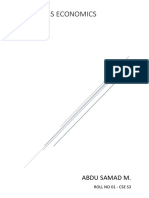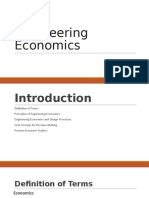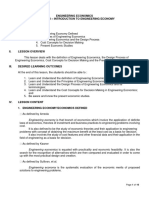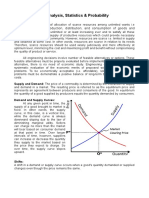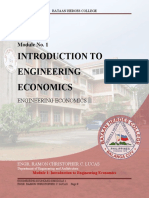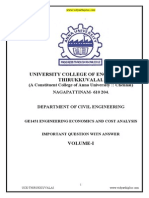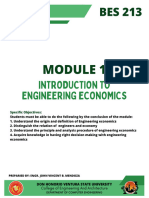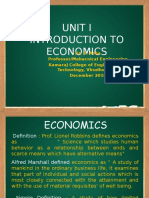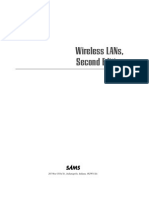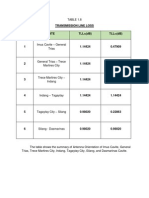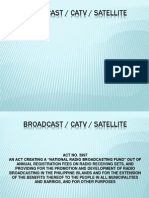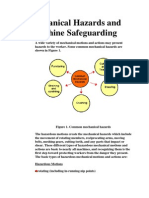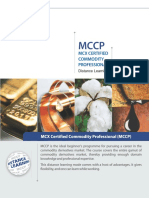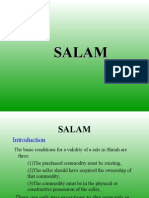Module 1 - Introduction Engineering Economy: Oikos Nomia
Module 1 - Introduction Engineering Economy: Oikos Nomia
Uploaded by
Vam ArmodiaCopyright:
Available Formats
Module 1 - Introduction Engineering Economy: Oikos Nomia
Module 1 - Introduction Engineering Economy: Oikos Nomia
Uploaded by
Vam ArmodiaOriginal Description:
Original Title
Copyright
Available Formats
Share this document
Did you find this document useful?
Is this content inappropriate?
Copyright:
Available Formats
Module 1 - Introduction Engineering Economy: Oikos Nomia
Module 1 - Introduction Engineering Economy: Oikos Nomia
Uploaded by
Vam ArmodiaCopyright:
Available Formats
MODULE 1 - INTRODUCTION ENGINEERING ECONOMY SCIENCE the foundation upon which engineering builds towards the advancement of mankind.
. ENGINEERING the profession in which a knowledge of mathematical and natural sciences gained by study, experience and practice is applied with judgment to develop ways to utiliz e economically the materials and forces for the benefit of mankind. ECONOMICS is the sum total of knowledge which treats of the creation and utilization of goods and services for the satisfaction of human wants. (from the Greek words oikos = household, nomia = laws) is one of the social sciences which consists of that body of knowledge dealing with people and their assets or resources. interaction between people and wealth; exchange of transaction. MACROECONOMICS modern economic analysis that is concerned with data in the aggregate as opposed to individual form. it concerns itself with an overall view of economic life, considering the total siz e, shape, and functioning of economic experience rather than the workings of individual parts. MICROECONOMICS modern economic analysis concerned with data in individual form as opposed to the aggregate form. It is concerned with the study of the individual firm rather than t he total population and the individual commodity rather than the total output. MANAGERIAL ECONOMICS
is that branch of economics which studies the application of the theories, tools, and findings of economics analysis to managerial decision making in all organizations which allocate limited or scarce resources. ENGINEERING ECONOMY is the branch of economics that involves the application of definite laws of economics, theories of investment and business practices to engineering problems involving cost. it is the study of economic problems with the concept of obtaining the maximu m benefit at the least cost. it involves the study of cost features and other financial data and their applications in the field of engineering as the basis for decision. process of determining whether an engineering project is to be undertaken or modified with the objective of obtaining the best utilization of capital resources taken into account some pertinent facts.
Reasons for Studying Engineering Economics 1. It will readily benefit mankind in general due to the more efficient use of wealth. 2. It will realize that engineering does not merely concern itself with technical asp ects, but will ultimately lead to economic considerations. Decision Making Process 1. Recognition of the problem. 2. Definition of goal or objective. 3. Identification of feasible alternative. 4. Selection of criterion or criteria for judging which alternative is best. 5. Predicting for the outcomes for each alternatives. 6. Choice of the best alternative to achieve objectives. Important Applications of Engineering Economy 1. Seeking of new objectives for the applications of engineering. 2. Discovery of factors limiting the success of a venture or enterprise. 3. Analysis of possible investment of capital. 4. Comparison of alternatives as a basis for decision. 5. Determination of basis for decision. Engineering Economy Technique 1. The economy analysis 2. The financial analysis 3. The intangible analysis Engineering Process (the total environment) PHYSICAL
ECONOMIC
Engg Proposal producers-consumers Eff = output/input goods-services Eff = worth/cost Want/Satisfaction
ECONOMIC CONCEPT (interaction between people and wealth)
PRODUCER
Goods-services
money
Goods-services
money
CONSUMER Consumer objective is get satisfaction of their properties or needs. Producer objective is to maximize profit in his business. Basic Terms and Principles of Economics 1. The success of engineering and business project is more commonly measured in terms of financial efficiency that in any other way. Rate of Return measure of the effectiveness of an investment of a capital. ROR = net profit/capital investment >= 15% 2. There are two types of life, namely: a. Physical life the time that it takes for the machine to function normally. b. Economic life
a function that has something to do with revenue. 3. Value designates the worth that a person attaches to an object or service. 4. Utility is the power to satisfy human wants, 5. Two classes of Goods: a. Consumer Goods products and services that directly satisfy the human wants or needs. b. Producer Goods also satisfy human wants but do so intently as a part of production process (example: bulldozers, ships, buildings, buses, etc.). 6. Two types of Goods: a. Luxuries necessities vary from person to person. b. Necessities products that are required to support human life/needs. 7. Two types of Factors that affect Economic Studies: a. Tangible Factors are those which can be expressed in terms of monetary values. b. Intangible Factors are those which are difficult to express definitely in terms of monetary values that cannot be measured.
8. Market is the place where the vendors or the sellers and buyers come together. Local Market
a limited locality where certain goods such as those which are perishable are sold. National Market certain goods sold all over the country. World Market goods that are exported to other countries. 9. Types of Marketing Strategies: a. Perfect Competition many sellers, many buyers. b. Monopoly one seller, many buyers. c. Monopsony - many sellers, one buyer. d. Duopsony - many sellers, two buyers. e. Oligopoly few sellers, many buyers. f. Oligopsony many sellers, few buyers. 10. Demand and Supply: Demand quantity of a certain commodity that is brought at a certain price and time. Demand depends on price, technology, taste and preference and resources. Law of Demand states that the demand for a commodity varies inversely as
the price of commodity. Supply is the quantity of a certain commodity that is offered for sale at a certain price at a given place and time. Supply depends on cost, technology and price. Law of Supply states that the supply of a commodity varies directly as the price of the commodity. Law of Demand and Supply under certain conditions of perfect competition, the price of a product will be such that the supply and demand are equal.
LAW OF DEMAND
LAW OF SUPPLY
Price
Price
Volume (Demand)
Volume (Supply)
LAW OF SUPPLY & DEMAND
D S Point E point where price is determined.
neither surplus nor shortage. Point N & O there is surplus of supply.
there is shortage of demand. Point P & R there is shortage of supply.
E there is surplus of demand.
P R
SELECTION IN PRESENT ECONOMY Present Economy means a condition wherein the worth of alternatives are evaluated in the basis of their present or immediate cost. Time- money relationship is not a factor. one important factor that must be kept in present economy studies is that the results of the various alternatives must substantially satisfactory. Design Methods Materials Site efficiency of workers Tools and equipment PRINCIPLES OF ENGINEERING ECONOMY 1. Develop the alternatives - The choice (decision ) is among alternatives. The alternatives need to be identified and then defined for subsequent analysis. 2. Focus on the differences - Only the differences in expected future outcomes among the alternatives are relevant to their comparison and should be considered in the decision. 3. Use a consistent viewpoint - The prospective outcomes of the alternatives, economic and other, should be consistent developed form a defined viewpoint (perspective). 4. Use a common unit of measure - Using a common unit of measure to enumerate as many of the prospective outcomes as possible will simplify the analysis and comparison of the alternatives. 5. Consider all relevant criteria - Selection of a preferred alternative (decision
making) requires the sue of criterion (or several criteria). The decision process should consider both the outcomes enumerated in the monetary unit and those Alternatives
expressed in some other unit of measurement or made explicit in a descriptive manner. 6. Make uncertainty explicit - Uncertainty is inherent in projecting (or estimating) the future outcomes of the alternatives and should be recognized in their analysis and comparison. 7. Revisit your decision - Improved decision making results from an adaptive process, to the extent practicable, the initial projected outcomes of the selected alternatives should be subsequently compared with actual results achieved. THE GENERAL RELATIONSHIP BETWEEN THE ENGINEERING ECONOMIC ANALYSIS PROCEDURE AND THE ENGINEERING DESIGN PROCESS Engineering Economic Analysis Procedure Engineering Design Process STEP
ACTIVITY 1. Problem recognition, definition and 1. Problem/ need definition evaluation. 2. Problem/ need formulation and evaluation. 2. Development of the feasible alternatives. 3. Synthesis of possible solutions
(alternatives). 3. Development of the outcomes and cash flow for each alternatives. 4. Selection of criterion (or criteria) 4. Analysis, optimization and evaluation
5. Analysis and comparison of the alternatives. 6. Selection of preferred alternative 5. Specification of preferred alternatives 7. Performance monitoring and 6. Communication post-evaluation of results. Sample problems: 1. Two types of filter are being considered for use in a diesel engine. Filter A requires a premium quality lubricating oilcosting P131.50 per liter. The filter and the oil will have to be changed after 1,000 hours of operation and 4 liters of new oil added after each 100 hours. This filter costs P150. Forty liters of oil fill the engine crankc ase. For filter B, a lower grade of oil costing P120.85 per liter may be used. This fil ter costs P175. In this case the filter would be changed each 1,000 hours, the oil completely changed after 500 hours and 4 liters of oil added after 250 hours of use. Which combination should be used?
2. A duplicating service will make electrostatic copies of documents up to 8 x 11 inches in size for 70 cents per copy for the first 10 and 40 cents per copy for all additional. It will also reproduce such documents by offset printing at a cost o f P3.00 for the master and 10 cents per copy with a minimum quantity of 30 bei ng required. a. assuming the each process gives satisfactory pieces, which will be more economical for 25 copies? b. At what quantity are the two processes equal in cost? 3. In manufacturing a certain machine part, it is necessary to make four holes in each part. Each hole will require 1 min. if drilled with the aid of a jig. The drill jig would cost P400 to construct and the drill press operator is paid P23.25 per hour. Overhead costs on the drill press are P12.00 per hour. The four holes can be made in 20 seconds on a punch press, but a die costing P650 will be required. It requires hour to set up the die on the press and the same period of time to tear it d own when the job is completed. Overhead charges for the punch press are P13.50 per hour. The press operator receives P23.00 per hour and the set-up man is paid P25.00 per hour. a. Determine the comparative cost for making 1,000 parts. b. Determine the number of parts to be made for equal cost. 4. On a certain automatic machine, 3 speeds are available for cutting head materials:
Speed A Speed B Speed C Output/hour 360 pcs 400 pcs 460 pcs Tool regrinding every: 12 hrs 10 hrs 8 hrs A set of tool costs P560 and can be ground 20 times. P60. Each regrinding costs
The time requires to regrind and change tool is 2 hrs. The machine operator is paid P22.75 per hour including toolchange time. The tool setter receives P15.00 per hour. Over head costs on the machine are P12.00 per hours including tool chan ge time. At which speed should the machine be operated? 5. A certain masonry dam requires 200,000 cu.m of gravel for its construction. The contractor found 2 possible sources for the gravel with the following data:
Source A Source B Ave. distance (pit-dam site) 3 km 1.2 km Gravel cost/cu.m at pit P10 Purchase price of pit P800,000 Road construction necessary P450,000 Overburden to be removed at P4.20/cu.m 90,000cu.m Hauling cost/cu.m/km P4.00 P4.00 Which source of gravel should the contractor consider?
You might also like
- Sample PDF of Tybcom Sem 6 Business Economics Smart Notes Book Bcom 3rd Year Mumbai University PDFDocument19 pagesSample PDF of Tybcom Sem 6 Business Economics Smart Notes Book Bcom 3rd Year Mumbai University PDFRajkumar Moota50% (2)
- Engineering Economy TechniquesDocument3 pagesEngineering Economy TechniquesAazyz HeartNo ratings yet
- Business Economics Notes For KTU StudentsDocument27 pagesBusiness Economics Notes For KTU StudentsAbdu Samad MNo ratings yet
- Parkingfee - Java (Use If 20Pts)Document2 pagesParkingfee - Java (Use If 20Pts)Belen0% (2)
- Atta CBDocument52 pagesAtta CBShashi Bhushan SonbhadraNo ratings yet
- IntroductionDocument30 pagesIntroductionBlessious Joseph LandoyNo ratings yet
- Section A 1. Define Engineering Economics: PRINCIPLE 1: Develop The AlternativesDocument12 pagesSection A 1. Define Engineering Economics: PRINCIPLE 1: Develop The AlternativesPrægña JulîetãNo ratings yet
- Introduction To Engineering EconomyDocument21 pagesIntroduction To Engineering EconomyHanilen CatamaNo ratings yet
- CE40Document5 pagesCE40Faye HidalgoNo ratings yet
- Unit 1Document51 pagesUnit 1Anonymous WVEy0mgGKNo ratings yet
- Chapter 1 - Engg EconDocument21 pagesChapter 1 - Engg EconJasNo ratings yet
- MG 6863 Engg Economics UNIT 1-5Document166 pagesMG 6863 Engg Economics UNIT 1-5KaviArasu100% (1)
- 4th Module Notes PDFDocument45 pages4th Module Notes PDFLikhith N GowdaNo ratings yet
- Module 12Document11 pagesModule 12Ranier Andrei VillanuevaNo ratings yet
- ECON 211 Notes 09 05 23Document3 pagesECON 211 Notes 09 05 23Christine Joy RemegioNo ratings yet
- ABE 306 (Not Complete) - 1Document33 pagesABE 306 (Not Complete) - 1ewaayomidotunNo ratings yet
- Introduction To Engineering EconomyDocument22 pagesIntroduction To Engineering Economyrhizhail cabalseNo ratings yet
- Assignment No 1Document4 pagesAssignment No 1furqanraeesNo ratings yet
- 1 IntroductionDocument21 pages1 IntroductionSe YiNo ratings yet
- Engineering EconomicsDocument21 pagesEngineering Economicspimavi9908No ratings yet
- MODULE ECONOMICS Chapter 1Document16 pagesMODULE ECONOMICS Chapter 1Michael AliagaNo ratings yet
- MODULE1 IntroductiontoEngineeringEconomy2022Document30 pagesMODULE1 IntroductiontoEngineeringEconomy2022sqp67n5h69No ratings yet
- E-6 Module 1 (Principles of Economics)Document36 pagesE-6 Module 1 (Principles of Economics)Dexter AlarconNo ratings yet
- Engineering Economics Learning Module 1-2Document39 pagesEngineering Economics Learning Module 1-2Oliver Jr SabadoNo ratings yet
- Unit 5 Economic Analysis, Statistics & ProbabilityDocument15 pagesUnit 5 Economic Analysis, Statistics & ProbabilityAchuta Mukund HarshaNo ratings yet
- Ce40 CPR1Document7 pagesCe40 CPR1Abigail VNo ratings yet
- Agen 566 - Engineering EconomicsDocument24 pagesAgen 566 - Engineering EconomicsAlex CampNo ratings yet
- Week 1Document20 pagesWeek 1Chariza MaicoNo ratings yet
- MATH322-f Week 1 and 2Document62 pagesMATH322-f Week 1 and 2Jordan RonquilloNo ratings yet
- 8 Mg2451 Eeca NotesDocument76 pages8 Mg2451 Eeca NotesDarshan KumarNo ratings yet
- Lecture 1 Introduction To Engineering Economy PDFDocument32 pagesLecture 1 Introduction To Engineering Economy PDFFrendick Legaspi100% (1)
- Untitled DocumentDocument8 pagesUntitled Documentsadun.chamika7065No ratings yet
- Introduction To Engineering Economics: Module No. 1Document22 pagesIntroduction To Engineering Economics: Module No. 1Rowell D. SinsayNo ratings yet
- SM300 MidsemDocument179 pagesSM300 MidsemDerek RocoNo ratings yet
- Module 1 EconDocument6 pagesModule 1 EconreesespufffNo ratings yet
- Module1 EconDocument30 pagesModule1 EconandreslloydralfNo ratings yet
- EE&PMDocument6 pagesEE&PMSAYAN MUSICNo ratings yet
- MODULE 1 - EEconDocument15 pagesMODULE 1 - EEconMark Anthony GarciaNo ratings yet
- University College of Engineering ThirukkuvalaiDocument7 pagesUniversity College of Engineering Thirukkuvalaiamsk24_24No ratings yet
- Introduction To Engineering EconomyDocument37 pagesIntroduction To Engineering EconomyAadeem NyaichyaiNo ratings yet
- Engineering Economics Module 1Document6 pagesEngineering Economics Module 1masterjoda7787No ratings yet
- Lect 1 - Principles of EE 28092022 120102pmDocument17 pagesLect 1 - Principles of EE 28092022 120102pmEeman ZubairNo ratings yet
- ECE 201 Unit 1 IntroductionDocument19 pagesECE 201 Unit 1 Introductionjethrocunanan04No ratings yet
- ES 123 Handouts Week 2Document10 pagesES 123 Handouts Week 2Owen FrancisNo ratings yet
- MG 6863 Engg. Economics Unit - I Introduction To EconomicsDocument29 pagesMG 6863 Engg. Economics Unit - I Introduction To Economicsanantharaman asha100% (1)
- Engineering EconomyDocument42 pagesEngineering EconomyGodofredo Luayon Jipus Jr.No ratings yet
- Chapter 1 PDFDocument14 pagesChapter 1 PDFआदित्य राज अधिकारीNo ratings yet
- In This CourseDocument49 pagesIn This CourseLalith Koushik GanganapalliNo ratings yet
- Introduction To Engineering EconomicsDocument35 pagesIntroduction To Engineering EconomicsRafiaNo ratings yet
- Engineering Economics and Accountancy Final PPT Unit-1Document64 pagesEngineering Economics and Accountancy Final PPT Unit-1Shashi KUMARNo ratings yet
- 1 1-1 3Document26 pages1 1-1 3Orlando Cruz SicoNo ratings yet
- Notes - EE 1Document37 pagesNotes - EE 1Ayeshá KhánNo ratings yet
- Engineering Economy NotesDocument4 pagesEngineering Economy Notesadamong99No ratings yet
- Definition of Economics:: Two Important Economic Conditions That Necessitate The Study of Economics?Document27 pagesDefinition of Economics:: Two Important Economic Conditions That Necessitate The Study of Economics?Navya NarayanamNo ratings yet
- Economy 1-14Document14 pagesEconomy 1-14Lorman MaylasNo ratings yet
- 1 Priciples of Engineering EconomyDocument32 pages1 Priciples of Engineering EconomyMaricar AlgabreNo ratings yet
- Module 1pbd 4 The SemDocument6 pagesModule 1pbd 4 The Semhisarahhh4No ratings yet
- Engineering Economy Lecture1Document33 pagesEngineering Economy Lecture1Jade Charlize22% (9)
- ECON 101 Notes + Study Guide - Standard: Introduction to MicroeconomicsFrom EverandECON 101 Notes + Study Guide - Standard: Introduction to MicroeconomicsNo ratings yet
- ECON 101 Notes + Study Guide - Gold Version: Introduction to Microeconomics at the University of AlbertaFrom EverandECON 101 Notes + Study Guide - Gold Version: Introduction to Microeconomics at the University of AlbertaNo ratings yet
- Catalysing Young Agri-Entrepreneurs' Investments and Ensuring Their Sustainability: Strategic Planning ToolFrom EverandCatalysing Young Agri-Entrepreneurs' Investments and Ensuring Their Sustainability: Strategic Planning ToolNo ratings yet
- Diff CircuitDocument4 pagesDiff CircuitVam ArmodiaNo ratings yet
- Cavite Province Frequency Plan: General TriasDocument6 pagesCavite Province Frequency Plan: General TriasVam ArmodiaNo ratings yet
- TheMobileConnectivityInfographic PDFDocument1 pageTheMobileConnectivityInfographic PDFVam ArmodiaNo ratings yet
- Villamor Test - 2 PDFDocument18 pagesVillamor Test - 2 PDFLocrian IonianNo ratings yet
- Student Information System: FunctionsDocument1 pageStudent Information System: FunctionsVam ArmodiaNo ratings yet
- Technical CV: Juan Cabrera de La CruzDocument2 pagesTechnical CV: Juan Cabrera de La CruzVam ArmodiaNo ratings yet
- OSI Model: A Review: COM47L Engr. Jonai RepublicaDocument32 pagesOSI Model: A Review: COM47L Engr. Jonai RepublicaVam ArmodiaNo ratings yet
- Power Distribution SystemsDocument120 pagesPower Distribution SystemscarlosmandopintoNo ratings yet
- Gprs Architecture: General Packet Radio Service (GPRS)Document6 pagesGprs Architecture: General Packet Radio Service (GPRS)Vam ArmodiaNo ratings yet
- E.engineering 6 EquationsDocument15 pagesE.engineering 6 EquationsVam ArmodiaNo ratings yet
- (2002 Sams) Wireless LANs - 2nd EditionDocument360 pages(2002 Sams) Wireless LANs - 2nd EditionVam ArmodiaNo ratings yet
- Banerjee 1 0302Document55 pagesBanerjee 1 0302Vam ArmodiaNo ratings yet
- Transmission Line Loss HOP Site TLL (DB) TLL (DB) : TX RXDocument3 pagesTransmission Line Loss HOP Site TLL (DB) TLL (DB) : TX RXVam ArmodiaNo ratings yet
- Broadcast / Catv / SatelliteDocument38 pagesBroadcast / Catv / SatelliteVam ArmodiaNo ratings yet
- LawDocument3 pagesLawVam ArmodiaNo ratings yet
- Mechanical Hazards and Machine SafeguardingDocument29 pagesMechanical Hazards and Machine SafeguardingVam ArmodiaNo ratings yet
- ' Semiconductor Materials and Diodes: Rizal Technological UniversityDocument8 pages' Semiconductor Materials and Diodes: Rizal Technological UniversityVam ArmodiaNo ratings yet
- Digital Television (DTV) Is The Transmission of Audio and Video by Digitally Processed andDocument5 pagesDigital Television (DTV) Is The Transmission of Audio and Video by Digitally Processed andVam ArmodiaNo ratings yet
- BJTDocument11 pagesBJTVam ArmodiaNo ratings yet
- Occupational Health and SafetyDocument13 pagesOccupational Health and SafetyVam ArmodiaNo ratings yet
- Pallavi Kapoor PDFDocument39 pagesPallavi Kapoor PDFPallavi KapoorNo ratings yet
- South Africa's Trade Flows - A Gravity Model AnalysisDocument130 pagesSouth Africa's Trade Flows - A Gravity Model AnalysisemmanuelNo ratings yet
- Index No 2Document7 pagesIndex No 2Parvathi M.SNo ratings yet
- Singer 1950 - US Foreign Investment in Underdeveloped Areas. The Distribution of Gains Between Investing and Borrowing CountriesDocument14 pagesSinger 1950 - US Foreign Investment in Underdeveloped Areas. The Distribution of Gains Between Investing and Borrowing CountriesMariano PortoNo ratings yet
- BusinessDocument5 pagesBusinessMuthu PathiNo ratings yet
- MKT 825 International MarketingDocument152 pagesMKT 825 International MarketingShalle said AdenNo ratings yet
- MCCP Commodity Programme DLP EnglishDocument2 pagesMCCP Commodity Programme DLP Englishanubhavg82No ratings yet
- Name Izna Registration # 2019-BCOM-009 Semester BS Commerce (II)Document7 pagesName Izna Registration # 2019-BCOM-009 Semester BS Commerce (II)IznaNo ratings yet
- Thompsons' Rubbish Theory Exploring The Practices of Value CreationDocument4 pagesThompsons' Rubbish Theory Exploring The Practices of Value CreationEleftheria AkrivopoulouNo ratings yet
- Bai Salam & IstisnaDocument41 pagesBai Salam & IstisnaAlHuda Centre of Islamic Banking & Economics (CIBE)No ratings yet
- Sethuraman - Priavte Label Marketing Strategies in Packaged GoodsDocument20 pagesSethuraman - Priavte Label Marketing Strategies in Packaged GoodsMassimiliano RizzoNo ratings yet
- John Jackson Ethnography Is. Ethnography AintDocument18 pagesJohn Jackson Ethnography Is. Ethnography AintDwayne DixonNo ratings yet
- The Eight Basic Consumer RightsDocument11 pagesThe Eight Basic Consumer RightsRyan Joseph DiazNo ratings yet
- The Standards of Weights & Measures Rules, 1977: Packaged CommoditiesDocument14 pagesThe Standards of Weights & Measures Rules, 1977: Packaged CommoditiesSomnath BanerjeeNo ratings yet
- Commodification or How Free Should Free Markets BeDocument7 pagesCommodification or How Free Should Free Markets BekimmielvNo ratings yet
- Share KhanDocument26 pagesShare KhanSubavel GousickNo ratings yet
- The # 1 Investment of The World's Wealthiest 1% and It's Now Available To YouDocument20 pagesThe # 1 Investment of The World's Wealthiest 1% and It's Now Available To YouSakthiNo ratings yet
- Economics Class 11 Project On DemandDocument14 pagesEconomics Class 11 Project On DemandKUNDARAPU SIRICHANDANA80% (10)
- Lotz - Fetishism PDFDocument19 pagesLotz - Fetishism PDFCarlos Andrés RamírezNo ratings yet
- DISS (Region III)Document33 pagesDISS (Region III)NylinamNo ratings yet
- R47 Introduction To Alternative InvestmentsDocument34 pagesR47 Introduction To Alternative InvestmentsSumair ChughtaiNo ratings yet
- Commodity RiskDocument3 pagesCommodity Riskjass1238061No ratings yet
- Pork and Bean ScriptDocument7 pagesPork and Bean Scriptsarahaventurero31No ratings yet
- Executive Summary: Ohio University Christ College Academy For Management Education 1Document73 pagesExecutive Summary: Ohio University Christ College Academy For Management Education 1Shoyeb MohdNo ratings yet
- Module 1 - Introduction Engineering Economy: Oikos NomiaDocument21 pagesModule 1 - Introduction Engineering Economy: Oikos NomiaVam ArmodiaNo ratings yet
- Jadees Srfson On WdeANNDocument13 pagesJadees Srfson On WdeANNRonitSing0% (1)
- Sociology Class 12 NotesDocument264 pagesSociology Class 12 NotesVaishnavi PrakashNo ratings yet


